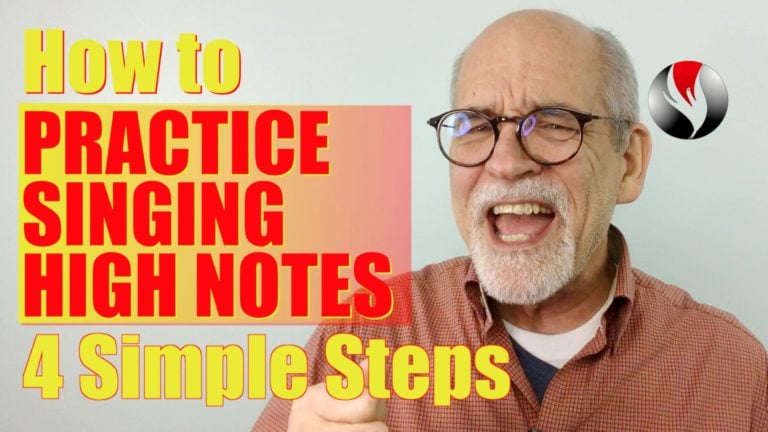Have you ever sung a high note and felt a lot of tension in your neck? Inside this video I’ll show you how to remove tension in the neck when holding a high note.
This week I received this question from a YouTube subscriber. He asked: How do you remove tension in the neck when holding a high note and why can it happen?
First, why does tension in the neck happen when holding high notes? Because in some way the voice is out of balance.
At the end of the song from Beauty and the Beast, If I Can’t Love Her, the final note ends on the F4 above middle C, which is in the middle of the men’s first bridge. Here are some ways the voice can get out of balance and cause tension on this ending note.
- Larynx rising [Demo]
- Pulling and forcing the chest voice too high [Demo]
- Vowel is spreading [Demo]
- Over-compression of vocal cords [Demo]
These things can cause the extrinsic neck muscles to squeeze and tighten around the larynx.
How to Remove Tension in the Neck When Holding a High Note
Here are 4 ways to remove tension in the neck when holding a high note.
#1. Keep the larynx low and resting. As an exercise substitute a dopy gee in place of the words. This holds the larynx down. Sing the phrase and the note with this dopy sound. Start out soft to medium volume. Do it several times until it feels balanced and comfortable.
As you repeat the exercise do it more normal until you completely eliminate the dopy sound while maintaining the lower larynx. [Demo]
#2. Learning to bridge from chest into head voice will help eliminate pulled chest on high notes.
If you can’t bridge, it’s very difficult to immediately bridge and sing the high notes without tension. It took me a long time to do it well enough to perform and even longer to do it confidently.
The fastest and easiest way to help you with this is to have you take the vocal test which I call the PowerTest at PowerToSing.com. Take this test and then take the quiz and discover your vocal type.
Once you know your vocal type, go to the Knowledge Center and watch the videos about your vocal type.
Download the vocal exercises and start practicing them. They’ll help you learn to bridge. Your progress can be rapid.
This will help you remove tension singing high notes faster and more consistently than anything else I can teach you.
- When the vowel spreads is sounds something like this. [Demo] This widening of the vowel shifts the resonance into the mouth and chest. It causes the larynx to rise and engages the outside muscles which creates tension and squeeze.
In this example narrowing the vowel from “May” to “Me” keeps the resonance in both the head and chest (mix) and enables you to sustain the note without the tension. If it spreads while you are sustaining the note, adjust the vowel from “May” to “Me”. You will immediately feel the tension leave. [Demo]
For more on vowel narrowing, watch Episode 25 on vowel modifying hacks. You can download a PDF of vowel modifications to help you. https://www.powertosing.com/ep-25-how-to-sing-high-notes-vowel-modifying-hacks/
- Over compression of the vocal cords means you are closing the vocal cords too tight. It’s likely this is happening because you are singing too loud or you are too worried your voice will crack or break while you are holding the note.
If you are cracking and breaking then you will be most helped by focusing on learning to bridge. Again, follow the directions in #2 above.
You can quickly reduce the over-compression by practicing at medium soft volume. Do this until you find a balance between the air flow and the vocal cords. [Demo]
Gradually increase the volume while maintaining the balanced air flow. If you begin over- tightening again, go back to the volume that worked without causing over-compression.
Here’s an exercise that will help you develop the ability to increase the volume without tension.
On the octave repeat scale, sing “new” to “no” like this. [Demo]
Be careful that the “no” stays in the same feel as the “new”. Don’t spread the “no” so that it falls into chest. [Demo]
Keeping it in the narrow place that the “new” was in will help you develop the power you want without grabbing and over-compressing the vocal cords. [Demo]
As you can see, this is probably not going to be an immediate fix. It will take time and preparation to do this confidently. But if you put the time in, it will work.
If you liked this video, give it a thumbs up, subscribe and share it with a friend. What’s the hardest thing about singing high notes for you? Let me know in the comment section below.
Also please join me, Power To Sing, on Twitter, Instagram and Facebook. I’d love to see you there too.
I’m Chuck Gilmore with Power To Sing. You can sing higher with beauty, confidence and power.
I’ll see you inside the next video.









Responses
Great! Glad it helped!
This is very helpful;its an answer. Thanks a lot!